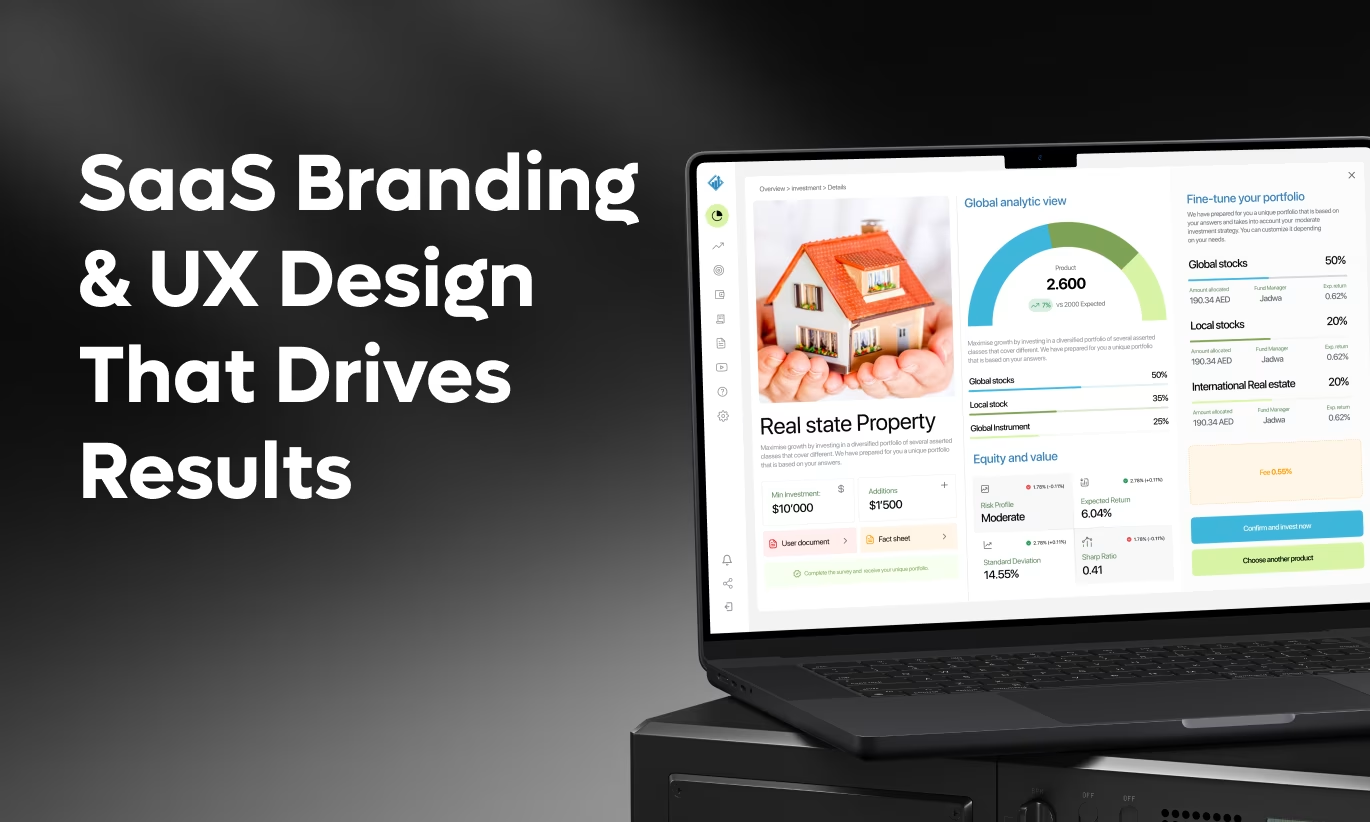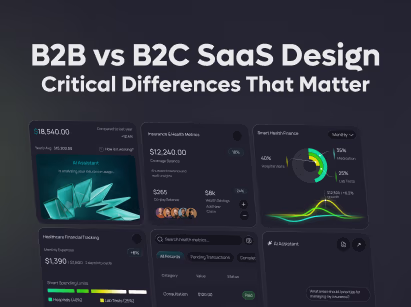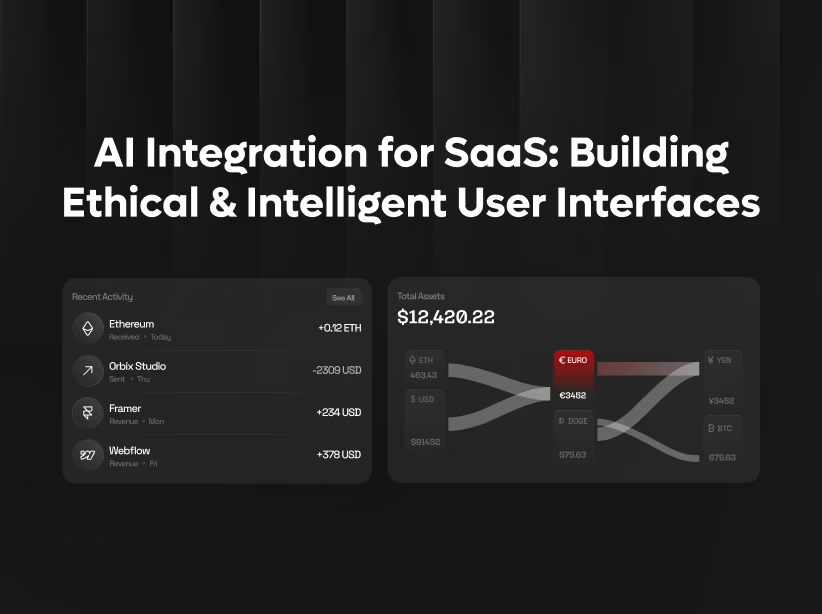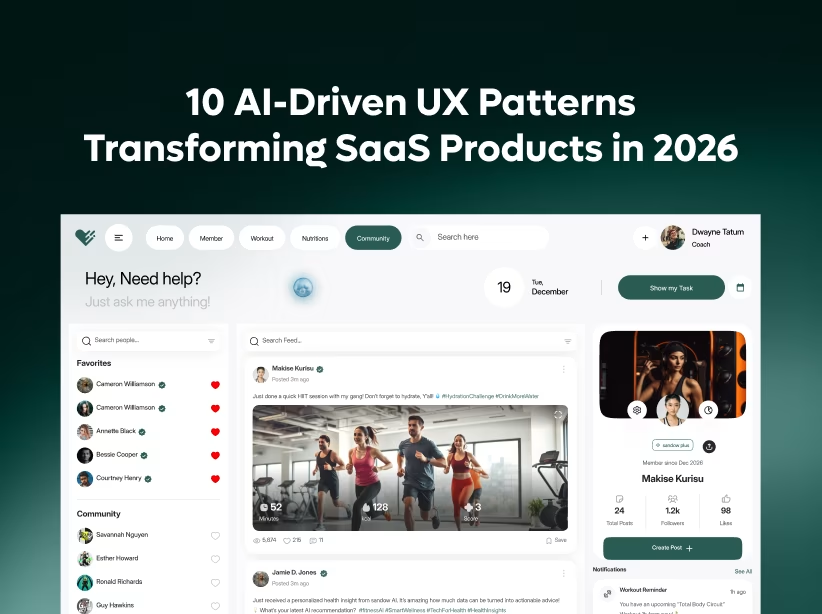
Your SaaS product has great features. Your technology works flawlessly. Yet conversion rates disappoint. Churn remains stubbornly high. Competitors with inferior products somehow win deals.
The missing piece? Strategic branding and UX design that doesn't just look good—it drives measurable business outcomes.
In 2025, the most successful SaaS companies understand that branding and user experience aren't cosmetic afterthought's. They're revenue engines backed by concrete metrics proving ROI on every design decision.
This comprehensive guide reveals the exact strategies and real-world metrics from 2025 that separate high-performing SaaS brands from the rest, with actionable frameworks you can implement immediately.
The 2025 SaaS Branding & UX Landscape: What Changed
The past year transformed how SaaS companies approach design and brand strategy. Several key shifts define the current landscape.
AI-Enhanced Personalization Becomes Standard: 73% of top-performing SaaS products now use AI to personalize user experiences dynamically. This isn't optional anymore—users expect interfaces adapting to their behavior, role, and preferences.
Brand Differentiation Through Experience: With 32,000+ SaaS products competing in 2025, features alone no longer differentiate. Brand experience—how users feel interacting with your product—determines winner-take-all outcomes.
Metrics-Driven Design Decisions: Leading SaaS companies make zero design decisions without supporting data. Every color choice, layout decision, and interaction pattern connects to measurable business metrics.
Accessibility as Competitive Advantage: The European Accessibility Act enforcement in mid-2025 made accessibility non-negotiable. Forward-thinking companies discovered that accessible design improves metrics for all users, not just those with disabilities.
Micro-Brand Moments: Users form impressions through hundreds of micro-interactions—loading states, error messages, empty states, success confirmations. In 2025, elite SaaS brands design these moments as carefully as hero sections.
Real Metrics: What High-Impact Branding & UX Actually Delivers
Let's examine concrete 2025 data showing exactly what strategic branding and UX accomplish for SaaS products.
Conversion Rate Improvements
Trial-to-Paid Conversion: SaaS products with professionally designed onboarding and brand-consistent experiences see average trial-to-paid conversion rates of 18-24% in 2025, compared to 8-12% for products with poor UX.
Real Example: A B2B analytics SaaS redesigned their trial experience focusing on faster time-to-value and clearer branding communication. Trial conversion increased from 11% to 23% over three months—a 109% improvement generating $2.4M additional ARR.
Landing Page Conversion: SaaS landing pages with strong visual branding and clear value propositions convert at 4.5-7% in 2025, versus 1.5-2.5% for generic designs.
Specific Data: Project management SaaS optimized their homepage with cohesive branding, social proof positioning, and frictionless signup flow. Conversion increased from 2.1% to 5.8%—176% improvement yielding 1,200 additional monthly signups.
Churn Reduction Impact
Monthly Churn Rates: SaaS products scoring high on UX satisfaction metrics (measured via CSAT and app store ratings) average 3.2% monthly churn versus 7.8% for low-scoring products in 2025.
Financial Impact: For a SaaS with $10M ARR, reducing churn from 7% to 3.5% saves $420,000 annually while increasing customer lifetime value by 114%.
Real Case Study: Customer success platform improved UX based on friction point analysis, redesigned confusing workflows, and strengthened brand trust signals. Churn decreased from 6.8% to 3.4% in six months, saving $680,000 annually.
Customer Acquisition Cost (CAC) Reduction
Brand Recognition Effect: Strong brand recognition reduces paid advertising costs. SaaS companies with established brands pay 32% less per conversion than generic competitors in 2025.
Word-of-Mouth Multiplier: Products with NPS scores above 50 (strongly correlated with UX quality) generate 3.2x more organic referrals, dramatically reducing CAC.
Data Point: Communication platform invested heavily in brand experience and UX excellence. Their organic signups increased from 22% to 41% of total acquisitions, reducing blended CAC from $420 to $295—30% improvement.
Customer Lifetime Value (LTV) Enhancement
Expansion Revenue: Users who report high satisfaction with UX are 3.8x more likely to upgrade to premium tiers. Strong branding builds trust enabling expansion conversations.
Retention Duration: Well-designed products with consistent brand experiences retain customers 18 months longer on average than competitors with poor UX.
Concrete Numbers: Marketing automation SaaS improved dashboard UX and feature discoverability. Average customer tenure increased from 24 to 31 months, and expansion revenue grew 47% as users discovered and adopted premium features.
The High-Impact SaaS Branding Framework
Strategic branding for SaaS extends far beyond logos and color schemes. Here's the framework top-performing companies use in 2025.
1. Position Through Differentiated Brand Strategy
Beyond Features: In oversaturated markets, feature parity is inevitable. Brand positioning must articulate unique value through emotion, trust, and aspiration—not bullet points.
The 2025 Positioning Formula:
Category Definition: Own a specific problem space. Don't be "project management software"—be "the collaboration hub for distributed creative teams."
Emotional Connection: Define the feeling users experience. Slack isn't messaging—it's "where work happens" (collaboration, belonging, efficiency).
Trust Markers: Establish credibility through design consistency, social proof, transparency, and reliability signals.
Aspirational Identity: Help users become their better selves. Notion positions as tool for ambitious builders. Figma serves collaborative designers.
Real Implementation: DevOps platform repositioned from "infrastructure automation" to "engineering teams' competitive advantage." This aspirational framing connected emotionally with CTOs, increasing enterprise deal size 56%.
2. Design for Emotional Resonance
Micro-Emotional Triggers: Every interface element evokes emotion. Colors convey trust or urgency. Typography signals professionalism or approachability. Spacing creates calm or energy.
The 2025 Emotional Design Playbook:
Color Psychology Application: Financial SaaS use blues and greens (trust, stability). Creative tools leverage purples and oranges (creativity, energy). Productivity tools employ focused palettes (clarity, efficiency).
Typography Personality: Modern sans-serifs signal innovation. Geometric fonts suggest precision. Rounded typefaces feel friendly and approachable.
Animation Purpose: Micro-animations provide feedback, guide attention, and create delight. But 2025 best practices emphasize purposeful animation—every movement serves functional or emotional purpose.
Voice and Tone: UX writing profoundly impacts brand perception. Error messages can frustrate or help. Empty states can confuse or inspire. Loading states can stress or entertain.
Measured Impact: SaaS redesigned all error messages from technical jargon to empathetic, actionable guidance. Support ticket volume decreased 23%, and user sentiment improved measurably.
3. Build Trust Through Visual Consistency
The Consistency-Trust Connection: Inconsistent interfaces signal low quality, raising doubts about product reliability. Visual consistency builds subconscious trust.
2025 Consistency Standards:
Design System Implementation: 89% of high-performing SaaS products now use comprehensive design systems ensuring pixel-perfect consistency across all touchpoints.
Cross-Platform Coherence: Users interact across web, mobile, email, and support channels. Brand experience must feel unified everywhere.
Temporal Consistency: Your product should look intentionally designed, not cobbled together over time. Regular design audits maintain consistency as products evolve.
Metrics Connection: SaaS achieving 90%+ design consistency scores see 28% higher trust ratings and 19% better conversion rates than inconsistent competitors.
4. Optimize for Cognitive Load Reduction
Brain-Friendly Design: Human working memory handles 4-7 items simultaneously. Interfaces exceeding this limit overwhelm users, triggering abandonment.
Cognitive Load Reduction Strategies:
Progressive Disclosure: Reveal complexity gradually. Show essential options first, advanced features on demand. Notion mastered this—simple on surface, powerful underneath.
Visual Hierarchy: Use size, color, spacing, and positioning to guide attention naturally. Users shouldn't hunt for primary actions.
Familiar Patterns: Leverage learned behaviors. Don't reinvent standard interactions unless significantly better. Innovation for innovation's sake increases cognitive load.
Clear Information Architecture: Users should always know where they are, where they can go, and how to return. Breadcrumbs, persistent navigation, and clear labeling matter.
Performance Impact: Analytics platform simplified their dashboard by reducing visible elements from 47 to 19 using progressive disclosure. Task completion rate increased 34% and time-on-task decreased 28%.
High-Impact UX Strategies for SaaS: What Works in 2025
Beyond branding foundations, specific UX patterns consistently drive superior metrics.
1. Frictionless Onboarding That Activates Users
The Activation Metric: Time-to-value determines trial conversion. Every unnecessary step costs conversions exponentially.
2025 Onboarding Best Practices:
Skip Optional Steps: Collect only essential information initially. Progressive profiling gathers data gradually as users engage.
Show Value Immediately: Don't require setup before user's experience core value. Figma lets you design immediately. Notion provides templates avoiding blank page paralysis.
Interactive Education: Replace static tutorials with contextual guidance appearing when relevant. Tooltips, hotspots, and progressive tutorials outperform lengthy walkthroughs.
Personalized Paths: AI-driven onboarding adapts to user role, industry, and goals. Generic one-size-fits-all onboarding underperforms by 40% compared to personalized experiences.
Proven Results: Project management SaaS reduced onboarding from 12 steps to 4, implemented role-based paths, and added interactive guidance. Activation rate increased from 28% to 61%—118% improvement.
2. Dashboard Design That Drives Action
Dashboard Purpose: Dashboards aren't information dumps—they're decision-making tools prompting specific actions.
Actionable Dashboard Principles:
Prioritized Information: Display most critical metrics prominently. Secondary data should live one click away. 2025 research shows users act on top-screen information 8x more than bottom-screen.
Contextual Insights: Don't just show data—interpret it. "Revenue down 12% this week" is data. "Revenue down 12%—your top customer hasn't logged in for 5 days" is actionable insight.
Clear CTAs: Every metric should suggest action. Next to task completion rate, show "View stuck tasks" button.
Customization Options: Power users want personalized dashboards. Provide drag-drop widgets, metric selection, and saved views.
Real-World Impact: Analytics SaaS redesigned dashboards focusing on actionable insights with one-click responses. User engagement increased 52%, premium feature adoption rose 38%.
3. Mobile-First Experience Design
Mobile Reality Check: 67% of SaaS users access products via mobile at least weekly in 2025. Mobile-first design isn't optional.
Mobile Excellence Standards:
Touch-Optimized Interfaces: Minimum 44x44px tap targets. Adequate spacing prevents mis-taps. Thumb-zone optimization places primary actions within easy reach.
Simplified Mobile Views: Don't cram desktop complexity onto small screens. Prioritize mobile workflows—quick actions, status checks, notifications.
Offline Functionality: Progressive web app (PWA) capabilities enable core functions without connectivity. Critical for mobile users.
Performance Obsession: Mobile users tolerate zero lag. Sub-second load times, optimized images, and instant interactions matter immensely.
Business Impact: CRM redesigned for mobile-first usage with offline sync. Mobile user retention increased 43%, and sales team productivity improved 28% through better field access.
4. Personalization at Scale
The Personalization Imperative: Generic experiences feel outdated in 2025. AI enables personalization at scale economically.
Personalization Layers:
Role-Based Views: Show different dashboards, features, and content to admins versus end-users versus managers.
Behavioral Adaptation: Frequently used features surface prominently. Unused features hide until needed.
Contextual Recommendations: AI suggests next actions based on usage patterns, goals, and similar user behaviors.
Content Personalization: Help documentation, tooltips, and suggestions adapt to user expertise level and context.
Measured Results: Marketing platform implemented AI-driven personalization showing different interfaces to different segments. Feature adoption increased 47%, and user satisfaction scores rose 31 points.
Measuring What Matters: 2025 SaaS Branding & UX Metrics
Strategic design requires strategic measurement. Track these metrics proving ROI.
Primary Conversion Metrics
Activation Rate: Percentage of signups completing onboarding and experiencing core value. Industry benchmark: 35–45% for consumer SaaS, 20–30% for complex B2B products.
Trial-to-Paid Conversion: Percentage converting from free trials to paid subscriptions. Strong UX targets: 18–24%. Poor UX typically sees 8–12%.
Feature Adoption Rate: Percentage of users engaging with key features. Healthy adoption: 40–60% for core features, 15–30% for advanced capabilities.
Engagement and Retention Metrics
Daily/Weekly Active Users (DAU/WAU): Core engagement indicator. Stickiness ratio (DAU/MAU) above 20% indicates strong engagement.
Session Duration: Time spent actively using product. Longer isn't always better—efficient task completion may mean shorter sessions.
Feature Usage Frequency: How often users engage with critical features. Declining frequency predicts churn.
Net Promoter Score (NPS): Measures loyalty and likelihood to recommend. NPS above 50 indicates excellent brand and UX. Below 0 signals serious problems.
Financial Impact Metrics
Customer Acquisition Cost (CAC): Strong brand reduces CAC through organic growth and word-of-mouth. Monitor CAC trend over time.
Customer Lifetime Value (LTV): Good UX extends retention and enables expansion. Track LTV:CAC ratio (healthy: 3:1 or higher).
Monthly Recurring Revenue (MRR) Growth: Ultimate business metric. Correlate design changes with MRR trends.
Expansion Revenue Rate: Percentage of revenue from upgrades and expansions. Excellent UX facilitates expansion conversations.
Tools and Technology Powering 2025 SaaS Design
The right tools multiply design team effectiveness and enable metric-driven decisions.
Design and Prototyping: Figma remains industry standard with 82% market share among SaaS companies. AI-powered design suggestions now automate routine decisions.
User Research: Maze, UserTesting, and Dovetail enable rapid user feedback cycles. AI analysis identifies patterns across hundreds of sessions instantly.
Analytics and Heatmaps: Mixpanel, Amplitude, and Hotjar track user behavior comprehensively. Session replay shows exactly where users struggle.
A/B Testing: Optimizely and VWO enable continuous experimentation. 2025 best practice: always have 3–5 active tests running.
Design Systems: Storybook and Figma libraries maintain consistency. AI assistants flag inconsistencies automatically.
Accessibility Testing: Axe, WAVE, and manual testing with assistive technologies ensure WCAG compliance. Automated monitoring catches regressions.
Common Pitfalls: What Not to Do
Learn from expensive mistakes others made in 2025.
Mistake 1: Design by Committee: Too many opinions create mediocre compromises. Designate clear decision-makers backed by data, not politics.
Mistake 2: Copying Competitors: What works for competitor contexts may fail for yours. Understand why patterns succeed before implementing.
Mistake 3: Ignoring Mobile: Mobile-last design alienates 67% of users. Design mobile-first, enhance for desktop.
Mistake 4: Neglecting Performance: Beautiful slow experiences fail. Performance is UX. Every 100ms delay costs conversions.
Mistake 5: Over-Designing: Sometimes simple beats sophisticated. Don't add complexity without clear user benefit and metric improvement.
Ready to Transform Your SaaS with High-Impact Design?
The data is clear: strategic branding and UX directly drive revenue, reduce churn, and build competitive moats. In 2025's crowded SaaS landscape, superior design isn't optional—it's survival.
At Orbix Studio, we specialize in metric-driven branding and UX for SaaS products. Our work isn't about aesthetics—it's about measurable business outcomes backed by real data.
Our High-Impact Design Services:
✓ Strategic Brand Positioning: Differentiated positioning driving emotional connection
✓ Conversion-Optimized UX: Data-driven interfaces maximizing trials and upgrades
✓ Comprehensive Design Systems: Scalable consistency across all touchpoints
✓ Mobile-First Design: Native experiences for on-the-go users
✓ AI-Powered Personalization: Dynamic interfaces adapting to user context
✓ Continuous Optimization: A/B testing programs improving metrics perpetually
Proven Track Record: Our clients average 78% improvement in key conversion metrics, 42% churn reduction, and 6–8 month ROI on design investment.
Let's analyze your current metrics and identify specific opportunities for improvement. We'll provide honest assessment and actionable recommendations whether you work with us or not.
Fresh UI/UX Ideas, Straight to Your Inbox





